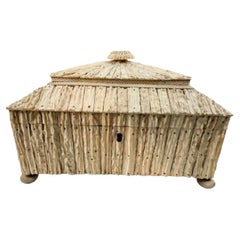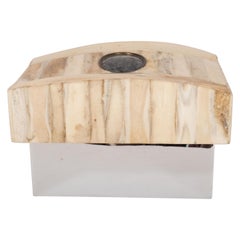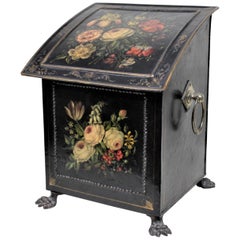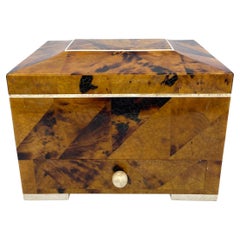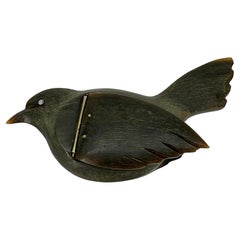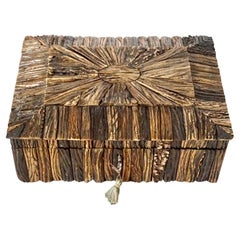Antler Decorative Boxes
5
to
4
1
5
5
5
1
4
1
1
1
Height
to
Width
to
384
3,547
3,080
1,094
931
3
3
3
1
1
Material: Antler
Anglo-Indian Stag Horn Veneered Sewing / Work Box From Vizagapatam
Located in Chapel Hill, NC
Anglo-Indian stag horn veneered sandalwood sewing or work box with a sloped two-tier lid having a carved finial above tapered sides and raised on compressed ball feet. The interior w...
Category
Mid-19th Century Indian Anglo Raj Antique Antler Decorative Boxes
Materials
Bone, Antler, Wood
Anglo-Indian 14"w Stag Horn Veneered Sandalwood Document/Storage Box
Located in Chapel Hill, NC
Anglo-Indian antler veneered work/storage made in Vizagapatam, of large size and having a double tiered sloped top with a large circular finial above vertically veneered sides, all r...
Category
Mid-19th Century Indian Anglo Raj Antique Antler Decorative Boxes
Materials
Antler, Horn, Wood
19th Century Anglo-Indian Vizagapatam Antler Veneered Sewing / Work Box
Located in Chapel Hill, NC
A fine Vizagapatam made antler veneered sewing / work box having tapered sides and a double tiered four-slope lid with a carved finial and all raised on four turned feet. The interio...
Category
Mid-19th Century Indian Anglo-Indian Antique Antler Decorative Boxes
Materials
Antler, Wood
Victorian Miniature Black forest Antler Casket 1860
Located in Berghuelen, DE
A marvelous antique rustic casket. It is made of wood, veneered with antler pieces. On top an antler plaque with staghound carving. The feet are made of ...
Category
Mid-19th Century German Black Forest Antique Antler Decorative Boxes
Materials
Antler, Wood
Mid-Century Modern Tessellated Antler, Chrome & Granite Box by Jonson & Marcius
Located in New York, NY
This bold and sophisticated decorative box was realized by the esteemed artisans Gene Jonson and Robert Marcius in the United States, circa 1970. This is a particularly stunning exam...
Category
1970s American Mid-Century Modern Vintage Antler Decorative Boxes
Materials
Granite, Bronze, Chrome
Related Items
Antique English Regency Toleware Footed Coal Box or Scuttle with Brass Handles
Located in Hamilton, Ontario
This antique metal coal box or coal scuttle is presumably made in England during the 1820s in the Regency period and style. The box is constructed of th...
Category
Early 19th Century English Regency Antique Antler Decorative Boxes
Materials
Metal
H 16.5 in W 12.5 in D 12 in
Mid-Century Modern Tessellated Horn & Stone Large Box, Tavola by Oggetti
Located in Banner Elk, NC
Mid-Century Modern Tessellated Horn & Stone large box, designed by Eugenio Tavola for Oggetti, of saracphagus shape with a hinged lid, the interior lined with original fabric, with a single drawer, the reverse with foil stamp, 'TAVOLA by OGGETTI.'.
Category
Mid-20th Century Italian Mid-Century Modern Antler Decorative Boxes
Materials
Stone
17th Century English Leather Covered Knife Box Converted To a Letter Box
Located in San Francisco, CA
17th century leather knife box converted to a letter box with original brass hardware, sitting on brass ball feet.
Fitted interior lined with 18th century silk fabric.
In very good...
Category
17th Century European Antique Antler Decorative Boxes
Materials
Brass
Malachite Box Fine Gemstone Jewelry Box
Located in Somis, CA
A stunning malachite box with a fantastic stripe pattern resembling images of inside of a cave. This exceptional piece uses carefully selected fine grade gemstone malachite in brilli...
Category
2010s Unknown Antler Decorative Boxes
Materials
Malachite
R&Y Augousti Box
Located in Henley-on Thames, Oxfordshire
Small vintage R&Y Augousti Art Deco style box
with inlayed faux bamboo decoration
retailers label to the underside
Paris France
circa 1990
R&Y Augousti was founded in 1989 by husband-wife duo Ria & Yiouri Augousti. Their artistic backgrounds brought them together as innovators in their field by reviving the artisanal techniques of shagreen and other exotic materials that were predominant in the Art Deco period of the 1930s.
Through their mix of vintage and contemporary design their furniture and home accessories brand were met with worldwide praise.
From a debut collection for the luxurious Hotel Crillon...
Category
Late 20th Century French Art Deco Antler Decorative Boxes
Materials
Brass
19C Anglo Indian Bombay MOP Sadeli Mosaic Trinket Box
Located in Dallas, TX
PRESENTING a LOVELY 19C Anglo Indian Bombay MOP (Mother of Pearl) Sadeli Mosaic Trinket Box from circa 1875-85.
Gorgeously detailed and hand-crafted ‘sadeli mosaic’ inlay, from the Bombay Area, with deep greens with silver, pewter, mother of pearl, bone and ebony in geometric patterns.
The box case, is made of sandalwood but completely covered in MOP, bone, faux ivory, ebony and mosaic inlay.
Edged with faux ivory and banded with a different pattern of sadeli mosaic.
Some minor damage to the top (repair is obvious in pics) and ivorine replacements to some edging, but it still a BEAUTIFUL BOX and of real QUALITY!
The mosaic work is FABULOUS!
Box opens to reveal its original blue velvet lining.
It sits on 4 (recently added) silvered button feet.
SADELI MOSAIC: “Anglo Indian boxes were made in India for the English residents from the early part of the 18th century. They were brought back or sent back to England usually by the people who had commissioned them. From the beginning of the nineteenth century they were imported more commercially, although not in any significant numbers until the middle decades. They were very highly valued, especially the early ones, to the extent that the designs were copied on late 19th and early 20th century tins.
The ancient art of Sadeli Mosaic is said to have been introduced from Shiraz in Persia via Sind to Bombay, a long time before the Anglo Indian boxes were made. It was a technique, which required a high degree of skill and patience. It was executed very lavishly, in that the frequent cuts wasted a great amount of the precious materials used. The workmanship was however more than commensurable to the value of the materials.
Ivory, silver, pewter (or other metals), wood and horn were cut into faceted rods which were bound together to form geometric patterns. When the glue has set, the rods were sliced in transverse sections. This gave the maker a number of angled circular pieces in the original pattern. Several variations of patterns could be achieved by combining the materials in different ways. The ivory was sometimes dyed green to give an extra color.
The mosaic pieces in a combination of patterns, often separated by ivory, ebony, horn or silver stringing were used to veneer sandalwood boxes. In the early boxes, which date from the turn of the 18th to the 19th century, there are large panels of mosaic covering tops and sides of boxes. It took incredible skill to cover such large areas without any shakes or wavering of the pattern. The corners and joins on these boxes are impeccably matched.
The makers (reputed to be Persian) of Sadeli mosaic made in the first two decades of the 19th century displayed a total understanding of the qualities of the different materials they used. They combined substances, which can expand and contract according to atmospheric conditions with others, which are hard and unyielding. The result was a sharp definition of the lines and patterns, which made up the whole design.
On the early boxes the designs look deceptively simple. The fact is, they emerged from a culture, which had mastered geometry and understood how to generate a pattern from a set number of points. The patterns are so harmoniously combined that their incredible complexity is not immediately apparent.
The earliest Sadeli boxes...
Category
Late 19th Century Indian Anglo-Indian Antique Antler Decorative Boxes
Materials
Silver
Malachite Box Large 6" Gemstone Jewelry Box
Located in Somis, CA
A beautiful 3.3 lb malachite box. This exceptional piece uses carefully selected fine grade gemstone malachite in brilliant green, displaying concentric rings, swirls and stripes. Bo...
Category
2010s Unknown Antler Decorative Boxes
Materials
Malachite
7 Antique & Vintage Painted Folk Art Bentwood Boxes Shaker Pantry Storage
Located in Dayton, OH
Seven vintage and antique 20th century Shaker style miniature bentwood boxes painted in a variety of colors, two forming the image of a Halloween j...
Category
Early 20th Century Shaker Antler Decorative Boxes
Materials
Bentwood, Paint
Painted Decorated Anglo Indian Box with Elephants
Located in Palm Beach, FL
A very charming Anglo Indian painted decorated box with elephant, people, peacocks and mystical animal motifs, an outside bracket base and a brass...
Category
Early 20th Century Indian Anglo-Indian Antler Decorative Boxes
Materials
Hardwood
Anglo Indian Micro Mosaic Inlay Jewelry Box
Located in New York, NY
Exquisitely crafted early 20th century Anglo Indian micro mosaic Sadeli box with gorgeous antique Persian geometric pattern.
The finely detailed box featu...
Category
Early 20th Century Indian Anglo-Indian Antler Decorative Boxes
Materials
Fruitwood, Bone
19c Anglo Indian Highly Carved Padouk and Sandalwood Sarcophagus Sewing Box
Located in Dallas, TX
PRESENTING A VERY NICE 19C Anglo Indian Highly Carved Padouk and Sandalwood Sarcophagus Sewing Box.
Made in Bombay, India circa 1890-1900.
The box case/body is made of sandalwo...
Category
Late 19th Century Indian Anglo-Indian Antique Antler Decorative Boxes
Materials
Bone, Padouk, Sandalwood
H 4.5 in W 12.5 in D 8.75 in
19C Anglo Indian Highly Carved Padouk and Sandalwood Sadeli Mosaic Sarcophagus S
Located in Dallas, TX
PRESENTING A GORGEOUS 19C Anglo Indian Highly Carved Padouk and Sandalwood Sadeli Mosaic Sarcophagus Sewing Box.
Made in Bombay, India circa 1860-80.
Box made of sandalwood with highly carved padouk wood reliefs and panels on all sides.
Edged with bone and ebony veneers and glorious sadeli mosiac, made from tiny pieces of faux ivory, pewter, green semi-precious stone.
The box is in a sarcophagus form with domed lid.
The original brass carry handles are on the sides.
The interior is in great condition and consists of a removeable mirror under the lid portion, with the original red velvet lining behind it.
The base is removeable and contains a number of lidded compartments.
6 of the interior lids on the base, are each inlaid with sadeli mosaic banding. The rest are also carved and chased.
The interior is fully complete with 7 lidded faux ivory/bone, thread canisters with sadeli domes and the original bone thimble.
The box sits on 4 brass ball or bun feet with the original velvet lining on the base.
Some minor repairs and losses, but this box is fully complete. This is ‘rare’ as many of these boxes have not survived in such condition!
Included in the sale are 2 photos that were in the box (under the base tray). Interestingly, one of them is a view of downtown Nassau, New Providence (Bermuda) from the early 20C and stamped on the rear. What a ‘journey’ this piece has made! Made in India … travelled to Bermuda, probably via Britain … back to Ireland (where we bought it) …. then to Texas!
These boxes were made by superb Indian craftsmen, specifically for sale to the ruling British elite. These types of boxes, carved padouk and sandalwood, (whilst beautiful and superbly crafted) were of a lesser quality, than the more profusely and intricately mosaic inlay, tortoiseshell and ivory boxes, made for the British ‘Upper Classes’ in the areas of Bombay and Vizagapatam. These type of boxes were much more affordable back in 1880 (and indeed today) and would probably have been bought by mid-level diplomats, civil servants or visitors.
Sewing boxes (in general), were in EVERY Victorian home in Britain in the 19th Century and like other boxes etc were ‘status symbols’ of your place in society! The more ornate the box, the more ‘Upper Class’ you were!
Of it’s type, this one, is one of the very higher quality one’s, than the norm!
SADELI MOSAIC: “Anglo Indian boxes were made in India for the English residents from the early part of the 18th century. They were brought back or sent back to England usually by the people who had commissioned them. From the beginning of the nineteenth century they were imported more commercially, although not in any significant numbers until the middle decades. They were very highly valued, especially the early ones, to the extent that the designs were copied on late 19th and early 20th century tins.
The ancient art of Sadeli Mosaic is said to have been introduced from Shiraz in Persia via Sind to Bombay, a long time before the Anglo Indian boxes were made. It was a technique, which required a high degree of skill and patience. It was executed very lavishly, in that the frequent cuts wasted a great amount of the precious materials used. The workmanship was however more than commensurable to the value of the materials.
Ivory, silver, pewter (or other metals), wood and horn were cut into faceted rods which were bound together to form geometric patterns. When the glue has set, the rods were sliced in transverse sections. This gave the maker a number of angled circular pieces in the original pattern. Several variations of patterns could be achieved by combining the materials in different ways. The ivory was sometimes dyed green to give an extra color.
The mosaic pieces in a combination of patterns, often separated by ivory, ebony, horn or silver stringing were used to veneer sandalwood boxes. In the early boxes, which date from the turn of the 18th to the 19th century, there are large panels of mosaic covering tops and sides of boxes. It took incredible skill to cover such large areas without any shakes or wavering of the pattern. The corners and joins on these boxes are impeccably matched.
The makers (reputed to be Persian) of Sadeli mosaic made in the first two decades of the 19th century displayed a total understanding of the qualities of the different materials they used. They combined substances, which can expand and contract according to atmospheric conditions with others, which are hard and unyielding. The result was a sharp definition of the lines and patterns, which made up the whole design.
On the early boxes the designs look deceptively simple. The fact is, they emerged from a culture, which had mastered geometry and understood how to generate a pattern from a set number of points. The patterns are so harmoniously combined that their incredible complexity is not immediately apparent.
The earliest Sadeli boxes...
Category
19th Century Indian Anglo-Indian Antique Antler Decorative Boxes
Materials
Bone, Padouk, Sandalwood
H 5.5 in W 12.8 in D 9.15 in
Previously Available Items
Small Early 19th Century Antler Bird Snuff or Pill Box, France
Located in Haddonfield, NJ
Small antique French box as a Bird in Antler and with Brass Hardware, Circa 1810-1850's
This charming antique high quality box was originally use...
Category
Early 19th Century French Folk Art Antique Antler Decorative Boxes
Materials
Brass
Anglo-Indian Stag Antler Veneered Sandalwood Sewing Box, Vizagapatam, circa 1840
Located in Kinderhook, NY
A wonderful circa 1840 Anglo-Indian sewing box or caddy of Vizagapatam manufacture, the rectangular sandalwood case with working lock and key clad with exceptionally textured natural...
Category
Mid-19th Century Indian Anglo-Indian Antique Antler Decorative Boxes
Materials
Bone, Antler, Horn, Sandalwood
H 4.63 in W 11.13 in D 7.75 in
19th Century Anglo-Indian Vizagapatam Stag Antler Horn and Sandalwood Sewing Box
Located in Haarlem, NL
Very heavy and decorative mid-19th century Anglo-Indian sewing box made in Vizagapatam, India, circa 1860.
The box is made of sandalwood but covered in sections of carved antler hor...
Category
Mid-19th Century Indian Anglo-Indian Antique Antler Decorative Boxes
Materials
Antler, Horn, Sandalwood, Bone
H 9.45 in W 10.44 in D 9.65 in
Silver Box with Deer Antler Coverings, 900 Silver Hallmarked, Austria circa 1920
Located in Lichtenberg, AT
Extraordinary silver box with deer antler coverings elaborately made out of fine 900 Silver in Austria around 1920. This absolutely unique, hunting style box impress with gorgeous wo...
Category
Early 20th Century Austrian Antler Decorative Boxes
Materials
Silver
H 2.4 in W 10.2 in D 7.5 in
Antique Anglo Indian Vizagapatam Stag Antler Horn Sandalwood Document Box Casket
Located in Dublin, Ireland
A very impressive example of an Anglo-Indian stag antler horn gentleman’s document box of outstanding quality and generous proportions. Made in Vizagapatam, India, during the first q...
Category
19th Century English Grand Tour Antique Antler Decorative Boxes
Materials
Horn, Antler
H 4.75 in W 12.5 in D 5.75 in
Vizagapatam Carved Sandalwood Bone and Sadeli Mosiac Box
Located in Ottawa, Ontario
A Vizagapatam carved sandalwood
Bone and Sadeli Mosaic Box
First half of 20th century.
Measures: 8 in. L x 4 in. W x 2 3/4 in. H., (20 x 10.3 ...
Category
Mid-20th Century Indian Anglo-Indian Antler Decorative Boxes
Materials
Antler
Rare Miniature Antler Drawer Casket, 1860
Located in Berghuelen, DE
A marvelous drawer casket. Made of wood, veneered with horn pieces. Sides decorated with horn roses, on top a carved horn rose. Feet made of horn, carved in the shape of lions paws. ...
Category
Mid-19th Century German Black Forest Antique Antler Decorative Boxes
Materials
Antler
Recently Viewed
View AllMore Ways To Browse
Antique Campaign Boxes
Fan Box
Georgian Mahogany Box
Mother Of Pearl And Ivory
Chinese Box Gilt
Copper Lid Brass
Covered Porcelain Box
Antique Copper Hinge
Antique Copper Hinges
Antique Hat Boxes
Antique Hat Box
Antique Casket Boxes
Hat Box Antique
Green Ceramic Box
Art Deco Chrome Box
Strong Box Key
Wood Motifs
Vintage Dresser Boxes

